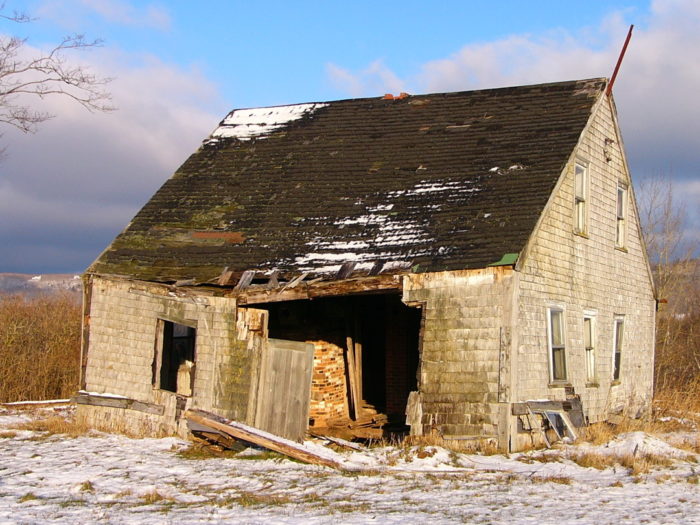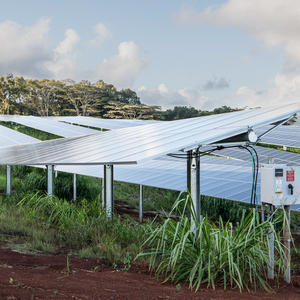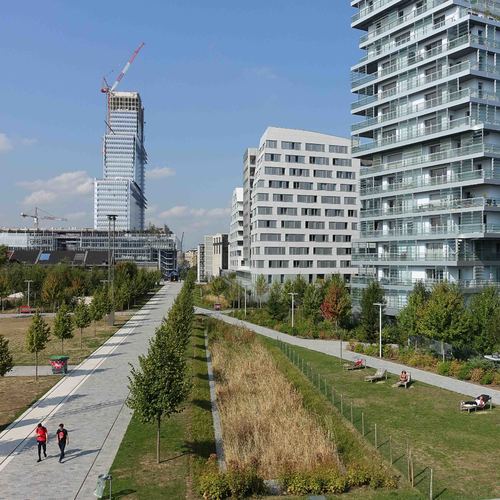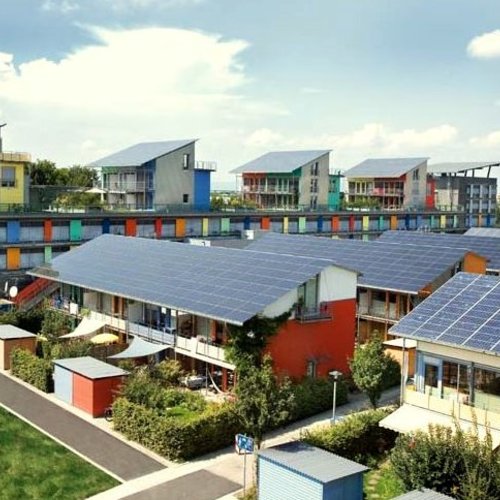
Image Credit: Public domain
When an architect, residential builder, and owner sit around a table for their first design meeting, their ostensible goal is to begin designing a house. Whether they realize it or not, however, these three people are also predicting the future.
If the team members are planning to build a code-minimum house in the suburbs, they are (in effect) predicting that the next thirty years will be similar to the last thirty years. The future homeowner expects to be able to afford to buy a car and to find enough fuel for the car to carry him or her to work and to the supermarket. The owner expects the local municipality to be able to deliver enough potable water for cooking, to keep a family clean, and to keep the lawn watered. And the owner expects energy prices to be stable enough to allow the home to be heated in winter and air-conditioned during the summer.
On the other hand, if the team members are planning to build a Passivhaus on an urban infill lot, they may be predicting that energy prices will rise or that fuel supplies will become tight.
And if the team members are planning to build a cistern-equipped house and barn on 10 rural acres, they may be predicting that water supplies and food delivery systems may be disrupted in future years.
Predictions of doom are nothing new
In 1973, when the first oil crisis caused fuel prices to spike, Americans could pick and choose from a variety of doomsday scenarios. Paul Ehrlich’s book, The Population Bomb, was still selling briskly. The Club of Rome’s report, Limits to Growth, predicted that future materials shortages (including energy shortages) would lead to a collapse of industrial economies. Tens of thousands of young hippies, convinced that the capitalist economic system was…
Weekly Newsletter
Get building science and energy efficiency advice, plus special offers, in your inbox.

This article is only available to GBA Prime Members
Sign up for a free trial and get instant access to this article as well as GBA’s complete library of premium articles and construction details.
Start Free TrialAlready a member? Log in















9 Comments
About that recent fall in oil prices...
"Since then, new drilling technologies have led to a boom in U.S. production of oil and natural gas (a development that is far from an unalloyed blessing). During the past year, oil prices have fallen sharply."
In the period since the fracking boom started when oil prices were in the $100/bbl range, demand for oil in the US has fallen by about the same volume that US oil output has increased. The amount of that US decline in demand is also about the same as the entire oil output of Iraq.
During the same period the growth curve of worldwide oil demand has shallowed, but not yet reversed. But WAY too much credit has been given to US tight-light fracked oil for the recent downturn in pricing. While the exact numbers vary by the geological formation and oil developer and the numbers are in SOME dispute, most industry analysts believe the break-even wellhead price for fracked oil over the lifecycle of the well is in the $75/bbl range. While it's still possible to make money pumping from fracked oil wells that are already producing, there is a high financial risk for drilling any NEW wells, and the financial backers of oil developers understand this. The number of drilling rigs operating in US shale formations has fallen off a cliff in the past quarter- nobody will put up the money to keep the "drill baby drill baby drill baby drill..." hamster wheel going until prices rise to a profitable level.
The average production life of a shale oil well is about 3 years, at which point 95% of all of the oil it will EVER produce is already out of the ground. Unless they keep drilling at the 2009-2014 pace, US oil production will begin to decline. The decline will be slow at first, but will accelerate as the number of wells approaching end-of-life become the majority. But whether that decline in US production will have a dramatic affect on the world price for oil remains to be seen, since it is but one factor (and not an overriding factor) in the oil market:
The REAL cause of the oil price decline is stagnant-to-declining economic growth in Europe, where oil demand was declining even with moderate economic growth, the declining demand in the US despite fairly healthy economic growth, and the reduction in economic growth rate in China over the recent decades' averages, combined with a policy shift in China away from oil and toward electricity as transportation fuel. In short, over the past 5 years almost ALL of the world demand growth for oil has been in China, with only modest a amounts of demand growth in the rest of the developing world, and outright decline in the developed world.
When the 800lb gorilla on the demand-growth side of the market gets a cold, all the players on the supply-growth side of the market begin to sneeze. The high-cost supply developers (offshore Arctic and tight-light shale, even new oil-sand development) gets the plague. The "missing" growth in anticipated Chinese demand that had led investors worldwide to invest in oil development may never develop if China doubles-down on it's transportation electrification policy (which they seem to be doing.) There is still relatively cheap oil plays in other parts of the world (many owned by nations with despotic government), and until world demand growth picks up faster than those developers can increase the pumping rate, the price of oil will stagnate.
The narrative that fracked oil has been the factor that has driven down the price of oil is truly myopic. It may have been A factor, but (keeping the animal models going :-) ), fracking at best the mouse, not the elephant in the oil-price market.
Note: At $100/bbl oil Mark Lewis from Kepler Cheuvreux (a big European investment bank) did a bit of analysis last year demonstrating that at $3/watt for utility scale PV (which is more than the current world price), investing $100 billion in PV at $3 watt would provide about the same transportation energy per dollar to where the rubber meets the road in an EV than investing the same money in $100/bbl oil and continuing to drive internal combustion engine cars. At $50/bbl the $3/watt PV provides almost twice as much energy per $ of invesment.
http://reneweconomy.com.au/2014/why-100bn-invested-in-wind-or-solar-will-produce-more-energy-than-oil-18002
The full analysis lives here: http://www.qualenergia.it/sites/default/files/articolo-doc/KC-ESG_Toil%20for%20Oil-1.pdf (See chart #3)
It currently costs about $2/watt to install utility-scale solar.
So, while there will continue to be price volatility in the oil markets, the falling cost of PV (with a long term learning curve of 22% reduction in cost every time the installed base doubles, which is every 2-3 years) will become a price damper for the high side of that volatility over the long term.
Meanwhile, Citi-Group (a big US investment bank) just announced a plan for $100 billion in financing for renewables by 2025(go figure!):
http://www.bloomberg.com/news/articles/2015-02-18/citigroup-sets-100-billion-financing-goal-for-climate-projects
If you want to know where the price of oil (or energy broadly is going long term, watch the policy decisions in China & India, very populous countries where energy use growth per capita are high. Both are betting heavily on PV- primarily because it's cheap and getting cheaper, and requires neither water resources nor fuel to work. Continuing to invest in high-cost oil plays is a bit like buying a lot of cat-5 cable, and the bankers know it.
We do indeed live in interesting times! I suspect the Saudis have read the analysis coming out of multiple banking sector sources showing just how close the decline of oil is, which may be one reason they are pumping now at any price, refusing to cut back, which keeps the world demand from going into rapid decline. Any oil that is still in the ground in 2050 is probably going to be a stranded asset.
So, will oil prices go up from here?
Yes!
Will oil prices go down from here?
You bet!
It's only a matter of what time frame you're talking about.
Does fracking to get the tight-light shale oil really make a difference of when & how the price of oil goes up or down?
Not much. It's a short-term game that only makes sense to play when oil is trading above $75/bbl, which is not a price that can compete with $2/watt PV in the transportation market over the long term. And that $2 / watt price in 2015 will become a buck a watt well before 2030.
Oil prices
Martin - Excellent article. Dana- excellent evaluation of oil vs. pv's. The price of oil may have something to do with the things you both have mentioned, but they come nowhere near explaining the dramatic decline in prices. Crude oil cost $100. last July ! Now it's around $50. There is no way that this has a LOT to do with supply and demand. Not a 50% drop in 6 mos. There are political and hedge fund factors at play. The Saudis dropped the price to hurt Iran, and Syria; they really don't like Assad. They also want to hurt Russia, who has supported Syria. These 3 countries can't produce oil as cheaply as the Saudis. The hedgefunders have been betting that the price would continue to rise, and when the Saudis pulled the rug out from under them, to support their own interests, the hedge funds were forced to sell all of their futures and options, driving the price down further. I'm no expert in these matters, but I read some about it,and our government really does not want the public, or the mainstream media, to know that a handful of people control prices and markets, and with good reason. Dana, could you explain why PV makes better economic sense when oil is at $50. vs. when it's at $100.? It would seem to me that cheap oil would make it harder to justify the up front costs of PV. No?
Our Future
Apostate! Apostate! There goes Martin being all sensible again.
>>>> The Cat 5 wiring was
>>>> The Cat 5 wiring was recommended as an excellent way to "future-proof" one's home. Needless to say, Tim has never used his Cat 5 wiring <<<<<
raises hand
at least the wire is cheap.......................
I do still prefer hard lines as the wireless can be flaky..............
Cat 5
Brings up an interesting point. For a decade I've just provided conduit for any tech wiring, reasoning that it allows for a variety of uses. Is adaptability a good buffer against an unforeseeable future? If so, some of the choices we make, which at present provide for more efficiency, may in the long run turn out to limit the house's future.
Probably the most adaptable house, which lends itself to renovations and replacement of its constituent parts, is a single story structure with an unconditioned trussed roof on a (much maligned) crawlspace. Building assemblies that are complex and interdependent, and those that fail if not kept in pristine condition, might be poor bets. So for instance spray foam compares unfavourably to batt insulation, and a complex air sealing strategy which might inhibit future changes may not be a useful thing to include in our present builds, despite the initial energy benefits they confer.
cost benefit oil vs pv ?
"investing $100 billion in PV at $3 watt would provide about the same transportation energy per dollar to where the rubber meets the road in an EV than investing the same money in $100/bbl oil and continuing to drive internal combustion engine cars. At $50/bbl the $3/watt PV provides almost twice as much energy per $ of invesment."
The last line confused me. How does cheaper oil provide less energy per dollar invested.
oil vs pv
funny I thought the same thing
I believe he is speaking of the investors perspective, IOW, cheap oil is a lousy investment
Rumors abound in the markets (response to Kevin Zorski)
Of course it's about supply and demand, but the price today also about anticipation of future supplies and demand. The fact that unrest in oil supply countries and international sanctions against others has failed to make the market sufficiently anxious about future supply to raise the price only underlines these facts:
The previously anticipated level of growth in demand from China failed to materialize, and the pumping capacity from all suppliers is more than adequate to cover the adjusted estimates of near-future demand. OPEC pumping capacity has not increased dramatically over the past 5 years except in Iraq, one of the very zones where that capacity is being diminished and under stress, a condition that under times of tight supply would cause prices to spike. Instead that situation is being met by a massive yawn in the market, along with the increased sanctions against oil producers Russia & Iran. This is definitely supply & demand, and the near-future anticipation thereof.
Debra: I guess I need an editor! :-) If you look at chart 3 on p.15 (pdf pagination) of the full analysis link, you'll see than $50/bbl oil produces nearly twice the energy where the rubber meets the road than $3/watt PV does, and not conversely as I wrote.
Also note, the $/bbl numbers in that analysis is the price at which the oil producer breaks-even. $50/bbl is below the break even point for most tight-light shale plays, and is roughly the break-even point for oil sand plays.
Mind you, the actual world price for large scale solar is already trending toward $1.50/watt , which may end up being the 2015 price, so there is already rough parity with $50/bbl oil. Buck a watt PV is coming. Residential scale PV in both Australia & Germany costs less than $2.50, Solar-City's US cost is now ~ $2.10. Electrification of the transportation sector in China under their new policy directions will put downward pressure on oil prices sooner than many in the oil-biz are willing to say out loud. If the US follows suit it's "game over" for the exotic high-cost oil suppliers, but the OPEC suppliers can still make it pay (and well) at $25/bbl, which is still competitive with buck-a-watt solar.
Designing for Futures
It might be useful to look at this through a risk/benefit lens. A house that depends on less (less maintenance, less energy, less technological complexity) will be a more adaptable and future-proof building. Hi-tech, specialized, complicated systems are potential dead ends in an uncertain future.This is why I think it makes more sense to take care of heating and cooling on the demand side (by insulation) rather than on the production side (for example by technologically complicated heating systems coupled with PV) even if the latter appears to be financially easier right now.
I remember reading Stewart Brand's _How Buildings Learn_ many years ago. He makes the point that good buildings adapt, sometimes radically and in completely unforeseeable ways. So design and construction should not foreclose alternate uses and should include the inevitability of renovation. Tedd Benson's approach of building in chases for mechanical systems makes good sense to me.
A future proof building will be easy and safe to work on. For that reason I reject foam--there's a lesson to be learned from all the trouble we made with lead paint, asbestos, formaldehyde, PCBs etc. And designing for the future should ultimately include a cradle-to-cradle concern with the end of the life of a building and its components. The materials of buildings should be as reusable and benign as possible. The technologized building-as-machine-for-living idea breaks down when you are left with toxic waste at the end--an expensive and useless appliance that can't be fixed.
Log in or become a member to post a comment.
Sign up Log in